Increased deliveries and ordering activity ahead of Farnborough /// Boeing 737 MAX deliveries picking up pace


Ahead of this year’s Farnborough International Airshow, orders and deliveries picked up pace in June after a few uneventful months. On the deliveries front, Boeing handed over 44 commercial jets (compared to just 24 in May) while Airbus delivered 67 units. This compares to 60 deliveries for Boeing and 72 for Airbus in June of last year. Deliveries of the Boeing 737 MAX were considerably higher in June after several sluggish months due to Boeing’s ongoing overhaul of its quality management system and processes. Regulators have allowed Boeing to produce up to 38 737s per month, however, the company has opted to slow its production until it feels ready to return to the official production rate of 38 jets per month. With 34 737 MAX’s shipped out in June, Boeing has nearly returned to the official rate.
Year-to-date, Boeing and Airbus have delivered 175 and 323 aircraft compared to 266 and 316, respectively, during the first half of 2023. As of June, Boeing is 91 deliveries behind compared to last year’s totals to date, while Airbus is seven deliveries ahead. In 2023, in total, Boeing and Airbus delivered 528 and 735 aircraft compared to 480 and 663, respectively, in 2022. In 2023, Airbus won the deliveries crown for the fifth consecutive year.
Following a more than challenging 2020 due to the COVID-19 pandemic, 2021-23 were recovery years for the two largest commercial plane makers. Most likely, 2024 will be another year of recovery on the deliveries front followed by new records in 2025 and beyond. Boeing still has quite a way to go before setting new all-time company deliveries records, whereas Airbus will likely finish the year just below the pre-pandemic level. In 2018, before COVID-19 and the first 737 MAX grounding, Boeing delivered 806 jets, a level that will likely not be recaptured before the 2025-26 timeframe. Airbus’ record high of 863 shipments was set in 2019, a level that will likely be surpassed in 2025. Also, Airbus is expected to retain their deliveries lead for the foreseeable future due to the company’s comfortable backlog lead over its American rival. Before 2019, Boeing had out-delivered Airbus every year since 2012.
As indicated above, in June, Boeing delivered 44 jets, including 35 737s (34 MAXs / 1 NG), one 767, five 777s, and three 787s. For most of last year, the 737 program was producing aircraft at an official rate of 31 per month. At the end of 2023, the program completed the transition to 38 aircraft per month. However, increased quality checks and audits by regulators in the aftermath of the Alaska Airlines Flight 1282 incident mean that Boeing is currently producing 737 MAXs at a lower rate. In March, Boeing Chief Financial Officer, Brian West, stated: “We are the ones who made the decision to constrain rates on the 737 program below 38 per month until we feel like we’re ready.” Boeing hopes to return to its official production rate in the second half of this year and with 34 737 MAX deliveries in June, the company is progressing well towards this target. Boeing’s plans to increase production to approximately 50 737 MAX jets per month in the 2025/26 timeframe are still in effect. The target of 50 per month compares to the pre-crash/pre-pandemic rate of 52 737s per month in 2018. Last year, it was reported that the company is planning to boost production to 52 jets per month by January 2025. Boeing will open a new 737 MAX production line in Everett in the second half of 2024. The new line is in addition to the three lines currently in place at Renton. For now, in the aftermath of the Alaska Airlines Flight 1282 incident, the program will remain at 38 aircraft per month. Boeing ended Q1 2024 with 205 737 MAX jets in inventory, up five from Q4 2023. Boeing expects most of the inventoried jets to be delivered by the end of 2024. The company is still producing 737 NGs but now only has 14 737-800s remaining in backlog of which 12 are P-8 Poseidons for the U.S. Navy and allies.
The 787 program is currently ramping up production. In January of this year, the 787 production rate was raised to five per month, and more increases will follow until the program reaches the current target of 10 aircraft per month by 2025/26. However, Boeing is for now reducing the 787 rate to four before returning to five later this year. Boeing ended Q1 2024 with 60 Dreamliners in inventory, unchanged from Q4 2023.
The 767 program is currently producing jets at a rate of three units per month, a mix of KC-46 tankers (based on the 767-2C) and 767-300 freighters. The 777 program is currently pushing out aircraft at a rate of three per month. Most aircraft in backlog are 777 freighters, with only five 777-300ERs left. The 777 program was expected to get a new addition in late 2023 with the delivery of the first 777X, however, the 777X’s entry into service was postponed to 2025. Boeing recently reaffirmed the first delivery of the 777X will happen next year as planned. Boeing will also launch a new 777X-based freighter, thereby expanding its 777X and cargo portfolio. By the 2025/26 timeframe, Boeing expects to be delivering four 777s per month.
In June, Airbus delivered 67 jets, including seven A220s, 53 A320s (all NEO), three A330, and four A350s. On average, the company delivered 48 A320s per month in 2023 compared to 43 in 2022 and 44 year-to-date. Production is currently being increased, however, Airbus is no longer releasing their production rate changes and prefers to announce in what year they will reach a certain rate. At this time, we consider the unofficial A320 production rate to be 50 per month. Airbus is working with its supply chain to increase A320 production to 75 aircraft per month by 2027. Previously, the target of 75 was expected to be reached in 2026, however, in late June, Airbus pushed the target out by a year as suppliers are simply unable to keep up with demand. Also, Airbus cut its 2024 deliveries target from 800 to 770. The A320 program was expected to reach a monthly rate of 65 by late 2024, however, while Airbus did not specify whether this target has also been pushed out, we would now not expect this level of production to be reached before well into 2025. The commercial aircraft fleet is getting a new addition this year with the entry-into-service of the A321XLR. Final assembly of the first production aircraft commenced in December 2023 with entry-into-service expected to take place in Q3 2024. On 19 July, Airbus announced that the A321XLR has received its EASA type certification. This fall, the first A321XLR production aircraft is set to roll of the production line for delivery to launch customer Iberia, which will use its first aircraft on transatlantic flights.
The A220, meanwhile, is being produced at a rate of six aircraft per month, with a monthly production rate of 14 expected by 2026. Airbus is reportedly considering to introduce a stretch version of the A220.
The A330 production rate was increased from two aircraft per month to three at the end of 2022, with an increase to four per month expected this year. The A350 production rate was raised to six per month at the end of 2023 in line with Airbus’ announcements. Airbus expects to produce 10 A350s per month by 2026 and 12 by 2028.
Turning to the June orders review, in terms of reported bookings, Boeing had a quiet month and reported 14 gross orders from five different customers. Boeing reported two cancellations in June (a 737 MAX and a 787 Dreamliner), resulting in 12 net new orders. One or more undisclosed customers (perhaps Emirates SkyCargo) ordered five 777Fs, followed by four 777Fs for Turkish Airlines, and another two for BCA Customer Finance. Also, three 737 MAXs were ordered this month. Year-to-date, Boeing has accumulated 115 net new orders (156 gross orders), compared to 415 net new orders (527 gross orders) in the first six months of last year. Please note that last year’s figures include Paris Air Show held in June 2023. This week’s Farnborough International Airshow, will likely provide significant additional orders for both Airbus and Boeing. In 2023, Boeing booked a total of 1,314 net new orders (1,456 gross orders) – before ASC 606 changes – compared to 774 net new orders (935 gross orders) in 2022. Please note that for comparison reasons, we do not include Boeing’s so-called ASC 606 accounting adjustments in the numbers reported in this article and regard net new orders as gross orders minus cancellations. In addition to the above, on July 15, 2024, Boeing and California-based Aviation Capital Group (ACG) announced that the airplane lessor has finalized an order for 35 737 MAX jets, including 16 737-8s and 19 737-10s.
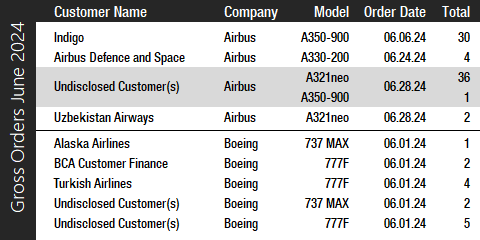
In June, Airbus booked orders from four customers for a total of 73 jets (gross orders) and reported no cancellations. The largest order (by # of aircraft) for 36 A321neos and a single A350-900 was placed by an undisclosed customer. Also, in June, IndiGo, a major Indian low-cost airline, ordered 30 A350-900s. Finally, Airbus Defence and Space placed an order for four A330-200s (A330 MRTT tankers – The Kingdom of Saudi Arabia is believed to be the end-customer), while Uzbekistan Airways booked two A321neos. Year-to-date, Airbus has accumulated 327 gross orders (17 cancellations => 310 net new orders), compared to 1,044 net new orders (1,080 gross orders) in the first half of last year. In 2023, Airbus won the orders crown for the fifth consecutive year booking an astounding 2,094 net new orders (2,319 gross orders), compared to 820 net new orders (1,078 gross orders) in 2022. In addition to the above, on May 20, 2024, Saudia, the national flag carrier of the Kingdom of Saudi Arabia, and flyadeal, the Saudia Group’s low-cost carrier, signed a firm order for an additional 105 A320neo Family aircraft. The order comprises 12 A320neo and 93 A321neo narrow-body jets. The order has yet to be added to Airbus’ books.
At the end of June, Airbus reported a backlog of 8,585 jets, of which 7,688, or 90 percent, were A220 and A320ceo/neo family narrowbodies. Airbus’ all-time backlog record of 8,626 jets was set in March 2024. Both manufacturers will likely set additional backlog records this year. By the end of last month, Boeing’s backlog (total unfilled orders before ASC 606 adjustment) was 6,156 aircraft, of which 4,730, or 77 percent, were 737 NG/MAX narrowbody jets. Boeing’s all-time backlog record of 6,259 aircraft was, just like Airbus, set in March 2024. The number of Airbus aircraft to be built and delivered represents 9.9 years of shipments at the 2019 production level (the pre-pandemic level), or 11.7 years based on the 2023 total. In comparison, Boeing’s backlog would “only” last 7.6 years at the 2018 level (the most recent “normal” year for Boeing), or 11.7 years based on 2023 deliveries. Boeing’s book-to-bill ratio year-to-date, calculated as net new orders divided by deliveries, is 0.66 with Airbus coming in a bit higher at 0.96. This means that both manufacturers are currently tapping into their backlog. Boeing’s book-to-bill ratio last year was 2.49 with Airbus coming in even higher at 2.85. This means that both companies received well over two new firm orders for every aircraft delivered.
Farnborough Preview
This year’s Farnborough International Airshow is being held from July 22-26 and, with both manufacturers finding themselves just a tad below their all-time order book record highs, we will likely see new all-time backlog records for both Airbus and Boeing. The 2024 edition of the show comes at a time when world passenger air travel has fully recovered and the world’s two major airplane manufacturers struggle to keep up with demand. This could result in higher airfares and a slower rejuvenation of the fleet. Two years ago, ordering activity at the show was a lot quieter than expected. 277 firm orders were placed with options for an additional 81 aircraft. This year, however, some expect that up to 1,000 aircraft will be ordered across all manufacturers. At last year’s Paris Air Show, 1,195 aircraft were booked.
At the show, Boeing is represented by a sole 787-9 on static display in the colors of Qatar Airways. Also, Boeing is showcasing a full-size 777X interior section. However, full-size 777X and 737 MAX aircraft will not be present. Meanwhile, Airbus is putting on a bigger commercial display. An Air India A350-900 will be displayed in the static area along with an A220-200. The flying display features an A330-900neo in Virgin Atlantic livery and Airbus’ A321XLR demonstrator aircraft.
Cebu Pacific is expected to finalize an order for over 150 Airbus A320neo Family jets, while Saudi Arabia’s Riyadh Air may opt for Airbus A320neo for its narrowbody fleet. Riyadh Air is targeting a fleet of 200 aircraft by 2030. Also, another Saudi carrier, Flyadeal, could announce a deal for widebody aircraft. Reports have also indicated that Vietnam Airlines is shopping around for a new regional jet fleet and will decide between either the A220 and Embraer E2.
2024 Forecast
Forecast International’s Platinum Forecast System is a breakthrough in forecasting technology that provides 15-year production forecasts. The author has used the Platinum Forecast System to retrieve the latest delivery forecast data from the Civil Aircraft Forecast product. For 2024, Forecast International’s analysts currently expect Boeing and Airbus to deliver 573 and 764 commercial jets, respectively. Please note that these figures exclude militarized variants of commercial platforms such as Boeing’s P-8 Poseidon maritime patrol aircraft and KC-46 Pegasus tanker and Airbus’ A330 MRTT tanker.
In its current year guidance, Airbus expects to deliver 770 planes in 2024 (target reduced from 800 last month), compared to 735 delivered in the previous year. Meanwhile, Boeing has decided to forgo issuing their 2024 production forecast as it focuses on safety and quality improvements in the aftermath of the Alaska Airlines incident in January. Boeing will report results for the second quarter on July 31. Airbus will report H1 2024 results on July 30.
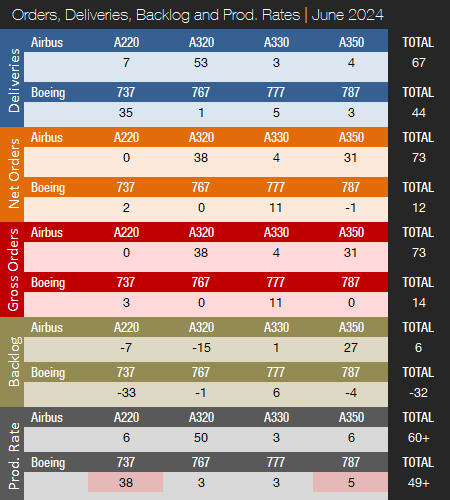
Note: Light red color for production rates means the program is temporarily producing at a lower rate than what is indicated in the table.
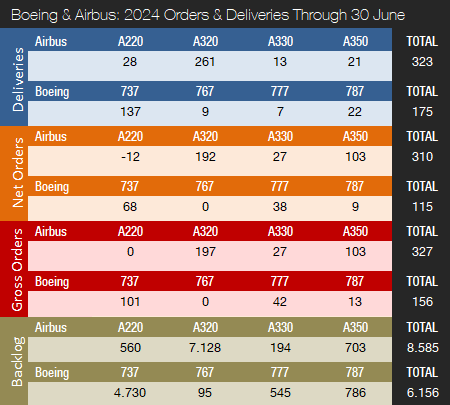

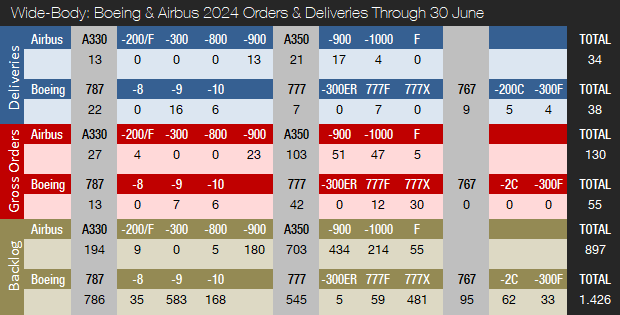
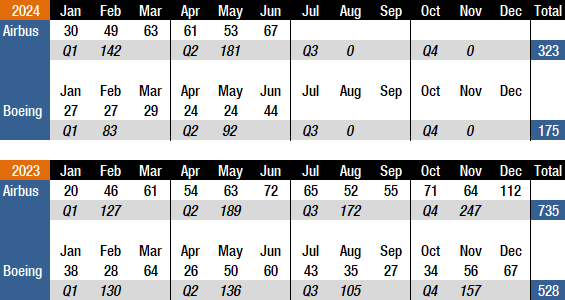
References:
- https://www.forecastinternational.com/platinum.cfm
- http://www.boeing.com/commercial/#/orders-deliveries
- https://www.airbus.com/aircraft/market/orders-deliveries.html
- https://boeing.mediaroom.com/2024-07-15-Aviation-Capital-Group-Grows-Boeing-737-MAX-Portfolio-with-Order-for-35-Jets
- https://investors.boeing.com/investors/news/press-release-details/2024/Farnborough-Airshow-Boeing-Adapts-Presence-to-Prioritize-Factory-Safety-and-Quality/default.aspx
- https://www.airbus.com/en/newsroom/press-releases/2024-06-airbus-provides-2024-guidance-update
- https://www.reuters.com/business/aerospace-defense/airbus-cuts-delivery-target-delays-production-goal-2024-06-24/
- https://www.airbus.com/en/newsroom/press-releases/2024-07-saudi-arabia-orders-four-additional-airbus-a330-mrtts
- https://www.airbus.com/en/newsroom/press-releases/2024-07-airbus-a321xlr-receives-easa-type-certification
- https://www.airbus.com/en/newsroom/press-releases/2024-05-saudia-group-orders-105-a320neo-family-aircraft-to-support-saudi
- https://www.airbus.com/en/newsroom/press-releases/2024-05-indias-indigo-orders-30-airbus-a350-widebody-aircraft
- https://www.aerotime.aero/articles/farnborough-international-airshow-2024-aircraft-preview
- https://www.globalair.com/articles/farnborough-international-airshow-2024-what-to-expect?id=7693
- https://aviationsourcenews.com/airshow/what-to-expect-from-the-2024-farnborough-air-show/
- https://simpleflying.com/what-to-expect-airbus-farnborough-international-airshow/
- https://simpleflying.com/no-test-planes-a-focus-on-safety-what-to-expect-from-boeing-at-the-farnborough-airshow/
Kasper Oestergaard is an expert in aerospace & defense market intelligence, fuel efficiency in civil aviation, defense spending and defense programs. Mr. Oestergaard has a Master's Degree in Finance and International Business from the Aarhus School of Business - Aarhus University in Denmark. He has written four aerospace & defense market intelligence books as well as numerous articles and white papers about European aerospace & defense topics.



